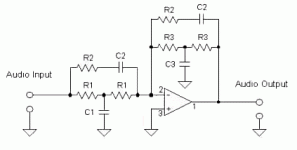"linkwitz transform"
Dont suppose you have a photo of what a LT looks like assembled?
i just had a look at the LT calculator online as it was readily available. the Caps and resistors is there any recommendation behind picking them? ie 250v or 400v and 10w and 5w etc.
THe triangle configuration confuses me a little as well, as it goes from positive from the amp, to negative, then splits?
THe triangle configuration confuses me a little as well, as it goes from positive from the amp, to negative, then splits?
Attachments
ok, as it happens, i just happen to have a 2.1ch class d amp board sitting in a box and a TEBM65. If i can figure out this LT filter, i could boost the 3.5inch in the 0.06 cuft box and i think the low pass will kick in around 100-140hz so it will act like a ghetto sub. as for the TEBM35's they can operate around that 80-100hz. if memory serves me correct, you would generally need to use a LT in a sealed box, is that correct?
Either that or the TEBM's with a oval shaped PR each (thinking from PUI Audio). They (PUI Audio) did have some interesting looking and sounding drivers as well, just not a lot of information and no reviews to speak of.
I had some scrap ply strips and glued them up to make a few 12mm panels and created an overall box with internal dimensions of 300x66x90mm (overall 0.06cuft)
Any thoughts @5th element @xrk971
Either that or the TEBM's with a oval shaped PR each (thinking from PUI Audio). They (PUI Audio) did have some interesting looking and sounding drivers as well, just not a lot of information and no reviews to speak of.
I had some scrap ply strips and glued them up to make a few 12mm panels and created an overall box with internal dimensions of 300x66x90mm (overall 0.06cuft)
Any thoughts @5th element @xrk971
The triangle is a circuit symbol for an opamp. The zigzag lines are resistors and the two lines capacitors. The other lines are the connecting wires, or traces on a PCB that link everything together.
Google opa2134 and look at the datasheet for an opamp. These aren't passive devices. They need a power supply. Or NE5532.
LTs only work with sealed enclosures. When designing the component values make sure to keep the resistor values low to minimise noise. Say aim to keep them between 500 and 10,000 ohms and size the capacitors to fit.
Google opa2134 and look at the datasheet for an opamp. These aren't passive devices. They need a power supply. Or NE5532.
LTs only work with sealed enclosures. When designing the component values make sure to keep the resistor values low to minimise noise. Say aim to keep them between 500 and 10,000 ohms and size the capacitors to fit.
The TB W1 2121S are excellent little drivers and paired with appropriate passive radiators will give bass extension down to 60Hz.
They have been specifically designed for T/S parameters that optimise perfectly for use with small ported or PR cabinets. Ported doesn't work well due to the need for a very long port in such tiny cabinets but with PRs things are good. They need an EBS alignment for the deepest bass.
Best thing is they have a flat frequency response and low distortion at drive levels you'd expect from them.
SB have three small full range drivers. The two largest ones are not suited to passive radiator/ported cabinets. You can use them sealed but to get decent extension you then need to use a linkwitz transform.
The SB65 sounds wonderful but needs the LT for decent bass. The W1-2121S goes deeper with PRs and uses less power doing it, it's much simpler to use in that regard but little monitors still need baffle step compensation.
The SB36 will optimise into a ported/PR enclosure although I haven't simulated with it to see just what it'll manage.
PUI Audio have what looks like a decent small PR that can be bought through mouser and most likely elsewhere too.
It's called the APR050SO-R
Then there are the Dayton DMA series. Careful simulation is needed to match the PRs to the drivers as they don't work as well together as DA would lead to you believe. Also careful selection is needed to get a design that will have good bass extension.
Attached is a picture of my Bluetooth W1-2121S speaker. As it happens I'm using them right now with my tablet to watch Netflix.
Hey mate, in your W1-2121s build did you use the PUI PR? Trying to model them in WiniSD at the moment but its missing the XMAX and VAS parameters for me to do it properly.
- Status
- This old topic is closed. If you want to reopen this topic, contact a moderator using the "Report Post" button.
